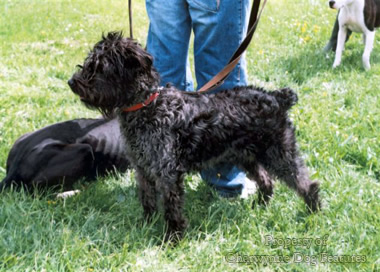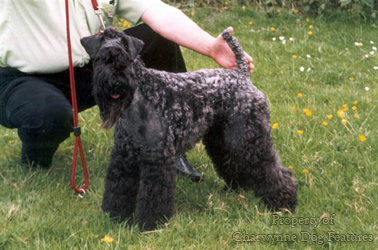744 KEEPING THE KERRY TERRIER
KEEPING THE KERRY TERRIER
by David Hancock
“Primarily, the Kerry Terrier is a water dog with the reputation of being very game in the work of otter-hunting.” – Robert Leighton, in his The Complete Book of the Dog, Cassell & Co., 1922.
It is likely that the modern breeds of purebred terriers from Ireland had common ancestors, becoming distinct breeds through county or locality specialisation in coat colour and leg length. It could so easily have been that today's Glen of Imaal Terrier became known as the Wicklow Terrier and the Kerry Blue as the Limerick Blue. Irish Blue Terrier may well be a more apt title for the Kerry Blue. In 1919 a club was formed in Dublin to promote the interests of the Irish Blue Terrier. It was not until 1921 that the name Kerry Blue was finally formally adopted for the breed. The Irish Terrier, before the standard was revised at the end of the 19th century, could be bright red, yellow, wheaten or grey. Grey was subsequently omitted. Half a century ago, blue puppies still featured in red and wheaten litters. 
In his The Twentieth Century Dog, published in 1904, Herbert Compton wrote: "...there was a terrier in County Wicklow (preserved distinct, and highly prized for a century) that was long in body, short in leg, and of a blue-black colour; there was a black terrier in County Kerry.. ." Soldiers of the House of Hesse, serving in Ireland, may well have brought pinschers with them, which would have produced a harlequin and a red factor. HD Richardson, in his Dogs, their Origin and Varieties of 1847, wrote of the harlequin terrier in Ireland: "In form, it is, as it were, a perfect English terrier; in colour it is a blueish slate-colour, marked with darker blotches and patches, and often with tan about the legs and muzzle. It is one of the most determined of its race..." That doesn't sound like a true harlequin to me, but what has been called 'marled', like clay with a mixture of blue-greys in it. Blue-grey Neapolitan Mastiffs can display this mixture of grey shades. Water dogs too, like the Poodle, can exhibit this chalybeous blue-grey coat. The romantic stories of dogs swimming ashore from Spanish ships near Tralee, sometimes featuring in fanciful Kerry Blue 'histories', may rest more fittingly in Irish Water Spaniel breed origins. Water dogs were ships dogs; terriers unlikely to be. The terriers of Ireland have more in common with each other than foreign breeds. But there are similarities with working dogs abroad.
When working in Ireland it was always of interest to study the pastoral dogs there; so many of them, shaggy and ungroomed, resembled the Bouviers of the Low Countries, their drovers’ dogs. Working in Germany, immediately after being in Ireland, allowed me to keep a picture of Irish farm dogs in mind when viewing their opposite numbers on mainland Europe. I have seen both schnauzers and wheaten terriers being used as herding dogs in their native countries and appearing interchangeable in form and way of working. At a World Dog Show, a decade ago, I saw a blue Bouvier that was astonishingly like a big Kerry Blue. Bouviers, like several of the Irish terrier breeds, are very much all-round farm dogs rather than specialist vermin-killers. Versatility however can mean that skill in one particular area is neglected; that hardly lessens a dog’s value, why keep three types when one can do everything?
The Kerry Blue will always be distinctive, but should always be physically sound. I've seen them with large thick ears, short on the leg and heavier in the skull than previously at shows. Their coats seem to be becoming heavier too. For me, the show specimens are too soft-muscled, display unsound front movement – usually from incorrect shoulder placements, weak rear movement with restricted forward reach and appear to be bred for their silhouette rather than their soundness. In the show rings I see exhibits that are prized for their haircut rather than their soundness, with soft wavy coats preferred to what I call goat-haired coats. The former has no doubt now become a ‘breed-feature’ but farmers will always go for a weatherproof coat than a ‘fancy-dan’ one; coat texture matters more in the pasture and the sporting field than in the warm covered artificial setting of a dog show. It is sad to see too the plague of modern terrier breeds manifesting itself in this one: short-stepping in front and no extension behind. As ever, in North America, the groomers and exaggerators are changing this admirable working breed into a placid over-schooled ornament, prized more for their eyebrows than any physical feat of value to man.
Every breed of terrier from Ireland used to be respected for its combative attitude, so valuable in a vermin-killer. Nowadays far too many of them have become soppy. A bad-tempered dog is a nuisance; one with some spark can be so much more easily trained. Energetic curious determined dogs are a joy to guide into a sporting function; lifeless lazy easily-thwarted ones rarely find a use. The terriers of Ireland were once renowned for their feistiness; I do hope in our increasingly urban world we do not undervalue them or change their characteristic approach to life. There is such a difference between a quarrelsome terrier and one eager to be useful, to be employed; terrier spirit should be treasured not bred out. Canine energy is so easily redirected; canine lethargy belongs on the hearth.
The Kerry Blue Terrier has never been highly popular, as a breed, in Britain, with around 200 being registered with the Kennel Club annually. This is better than over-popularity, which can ruin a breed. But I worry about the gene-pool size, the limitations of a one-colour breed and the fascination with coat in the breed’s show breeders. Health problems in the breed range from blood-clotting disorders, cataracts and missing or abnormal teeth. But in general the breed has good hips and elbows and heart disease is rare. Much more worrying are the health issues which accompany excessive hair: cancer of the hair follicle, sebaceous cysts, chronic ear infections caused by excessive ear-hair, eye discomfort from the insistence of heavy eye brows or a luxurious fringe and ‘dry-eye’. Allergic responses leading to dermatitis are also a common problem in this breed. The number of stud dogs available in any year need careful study so that the inbreeding coefficient in this distinctive breed is monitored.
Breeders of Kerry Blues face many challenges; there is concern that the breed is getting too big, that movement is getting worse and the pursuit of glamour in appearance has been given too high a priority. The choice of breeding stock in the next decade will be crucial. I understand that there is a strong dislike of black-coated dogs in this breed, which, bearing in mind the breed title may sound reasonable. But colour prejudice can narrow a gene-pool harmfully. Black and blue-coated dogs can be tolerated in breeds like the Great Dane and the Neapolitan Mastiff and can have merit through genetic diversity. Kerry Blue pups are born black but black adults in the breed are disowned. Would the integrity of this fine breed be threatened if black dogs were used in breeding programmes even if excluded from the show ring? The so-called ‘dilution’ colours such as blue have been linked with a greater risk of skin troubles and if this is true in this breed should provide reason for a coat-colour rethink. Which is more important: the health of the dogs or the ambitions of their fanciers? For myself, I’d rather have a sound robust durable Kerry Terrier than a flawed Kerry Blue.